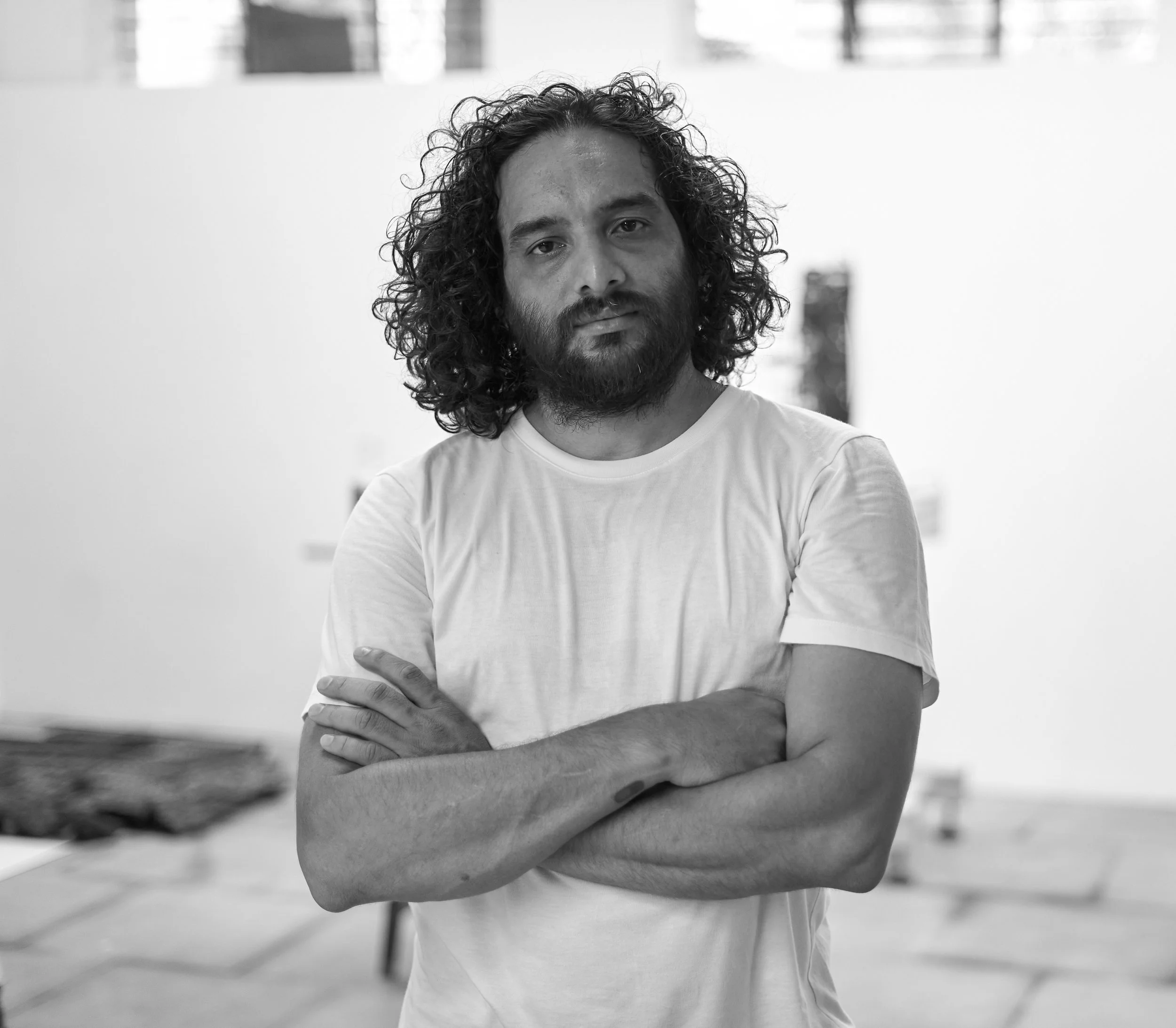Artists
-

Aku Zeliang
Aku Zeliang (b. 1992, Dimapur) is a designer and cultural entrepreneur who represents the second generation of designer-entrepreneurs in his family, carrying forward a legacy rooted in craftsmanship and cultural preservation. Drawing from his Naga heritage, Zeliang reinterprets tribal art forms through a contemporary design language that blends traditional techniques with modern aesthetics. As Creative Director of Heirloom Naga Centre and Cane Concept, and founder of Urra Design and Gallery Aku Zeliang, his practice highlights the cultural richness of Northeast India while fostering platforms for artisan-led innovation.
Since the early 1990s, his organisations have played a key role in reviving and promoting handwoven textiles and cane crafts across Nagaland and neighbouring states. Zeliang’s work has brought national recognition to indigenous practices while creating sustainable livelihoods for rural communities. With three EDIDA awards to his name, he continues to place Northeastern crafts on the global design map, championing both cultural heritage and community resilience.
-

Aphra Shemza
Aphra Shemza (b. 1988, UK) is a multimedia artist whose interactive sculptures and installations fuse technological innovation with cultural memory and sustainability. Drawing inspiration from her grandfather, celebrated abstract painter Anwar Jalal Shemza, her work explores Islamic heritage, modern geometric abstraction and future-forward modes of art-making. Shemza’s practice centers on accessibility, creating immersive experiences that invite audiences into participatory and reflective encounters with art.
With over a decade of experience, Shemza has exhibited internationally and received commissions from leading institutions including Tate Britain, Barbican, V&A, National Gallery, British Library, and Arts Council England. Her work has featured at Ars Electronica, Electronic Virtual Arts Conference, and Xi’an Maker Faire, and is held in collections such as the Oslo City Art Collection. As the co-founder of Art in Flux and the creator of ARTOLOGY, she champions sustainable art practices and digital innovation, making her a leading voice in contemporary media art.
-
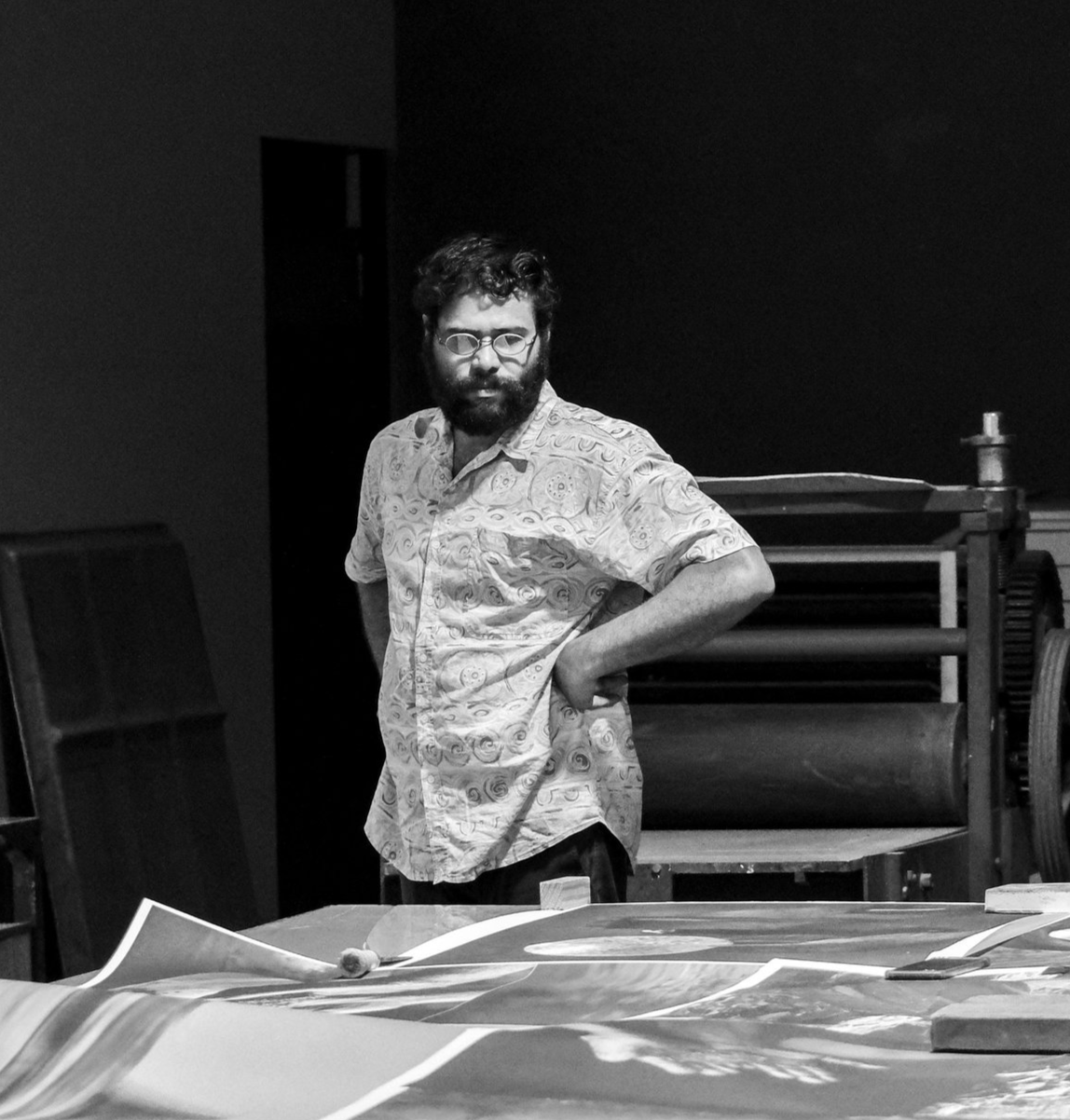
Awdhesh Tamrakar
Awdhesh Tamrakar (b. 1989) is an artist whose practice bridges tradition, material innovation, and social narrative. Rooted in the century-old Thathera brass and copper metalworking heritage, his work reimagines these forms through contemporary processes to explore themes of memory, displacement, and identity. Based between Hyderabad and Baroda and originally from Shahgarh, Madhya Pradesh, Tamrakar holds BFA and MFA degrees in Sculpture from the Faculty of Fine Arts, M.S. University of Baroda. He is currently Associate Professor at the S.N. School of Arts and Communication, University of Hyderabad.
Recent exhibitions include Dūr-darāz (Shrine Empire, New Delhi, 2022), Muted Mathaar (Triveni Art Gallery, New Delhi, 2021), and I WE Them (Bikaner House, New Delhi, 2025). He was awarded the PAIR (Prameya Artist-in-Residency) Award (2025) in partnership with Cité Internationale des Arts, Paris, and received the Gold Medal from the Faculty of Fine Arts, Baroda.
-

Ayesha Singh
Ayesha Singh (b. 1990, New Delhi) is an interdisciplinary artist whose practice spans participatory performance, kinetic sculpture, large-scale installations, and graphite drawings. Through architectural motifs and sculptural forms, she investigates how built environments encode power, influence identity, and alter historical narratives. Her work often involves community engagement and questions the politics of visibility in public space.
Singh has exhibited internationally at institutions including the Academy of Fine Arts (Vienna), Kiran Nadar Museum of Art (New Delhi), The Wolfsonian (Miami), Palazzo Madama (Turin), and Yorkshire Sculpture Park (UK). She was awarded the Van Gogh House Residency (London, 2022) and Emerging Artist of the Year by India Today (2020). Her work has been written about in major publications including Art Review, Art Forum, Architectural Digest, The Art Newspaper, Critical Collective, Wallpaper, Platform, and news media including The Guardian, recently, Singh’s work was written about in Phaidon Press’, Great Women Sculptors (2024) .
-

Chila Kumari Singh Burman
Chila Kumari Singh Burman (b. Liverpool) is a pioneering British artist known for her radical feminist practice exploring gender, cultural identity, and representation. A key figure in the British Feminist Art movement, Burman studied at the Slade School of Fine Art and works across printmaking, painting, installation, film, and neon. Her practice fuses personal mythology with political urgency, rooted in her Punjabi heritage and working-class upbringing. In 2022, she was awarded an MBE and an Honorary Doctorate from the Slade School of Fine Arts.
Burman’s acclaimed 2020 Tate Britain Winter Commission, Remembering A Brave New World, led to major public installations in Covent Garden, Liverpool Town Hall, and the Royal Pavilion. She has collaborated with Netflix and Byredo and featured in BBC and Sky Arts documentaries. In 2024, she was a finalist for the Fourth Plinth and launched solo shows at the Holburne Museum and Compton Verney. In 2025, her projects include Love Memoirs at the Nevill Holt Festival, I Love You, Southport at The Atkinson Gallery, a remake of The Thin Black Line at the ICA, and Chila Welcomes You at the Imperial War Museum (North), Manchester. Burman’s work is held in collections including Tate, V&A, Wellcome Trust and Science Museum, and the Devi Foundation.
-

Dhaqan Collective
Dhaqan Collective is a Bristol-based, Somali feminist art collective founded by Fozia Ismail and Ayan Cilmil. Rooted in resistance and cultural preservation, their practice imagines futures that protect and celebrate Somali heritage both in the diaspora and East Africa. Through everyday materials, cassette tapes, food, and textiles, Ismail and Cilmil create communal spaces of joy, memory, and healing that centre Somali diasporic experiences. They are residents at Watershed’s Pervasive Media Studio and studio holders at Spike Island.
Their work has been commissioned by institutions including the Serpentine Gallery, Sharjah Art Foundation, Southbank Centre, Arnolfini, and the British Library. In 2023, they received the WEVAA Fellowship for research into Black feminist material cultures and were named in Columbia University’s Digital Dozen: Breakthroughs in Digital Storytelling (2024). Dhaqan Collective’s evolving practice offers radical tools for cultural care and storytelling across geographies.
-

Floating Canvas Company
Floating Canvas Company is a creative enterprise based in India that works at the intersection of art, design, and technology. Founded in 2017 by Aagam Mehta, Rahul Singh Yadav, and Shakti Swarup Sahu, the collective specialises in large-scale public art projects that transform familiar spaces and invite audiences to imagine new possibilities for art.
From projection mapping and immersive spaces to experience centres and installations, their projects span both cultural and corporate collaborations, including work with the Ministry of Culture, Goethe-Institut, CSMVS Mumbai, Hampi Art Labs, Museum of Solutions Mumbai, Samsung, Hyundai, and JSW. Their public art initiative, Mumbai Light Festival, showcases light-based creations by artists and designers from India and around the world.
-
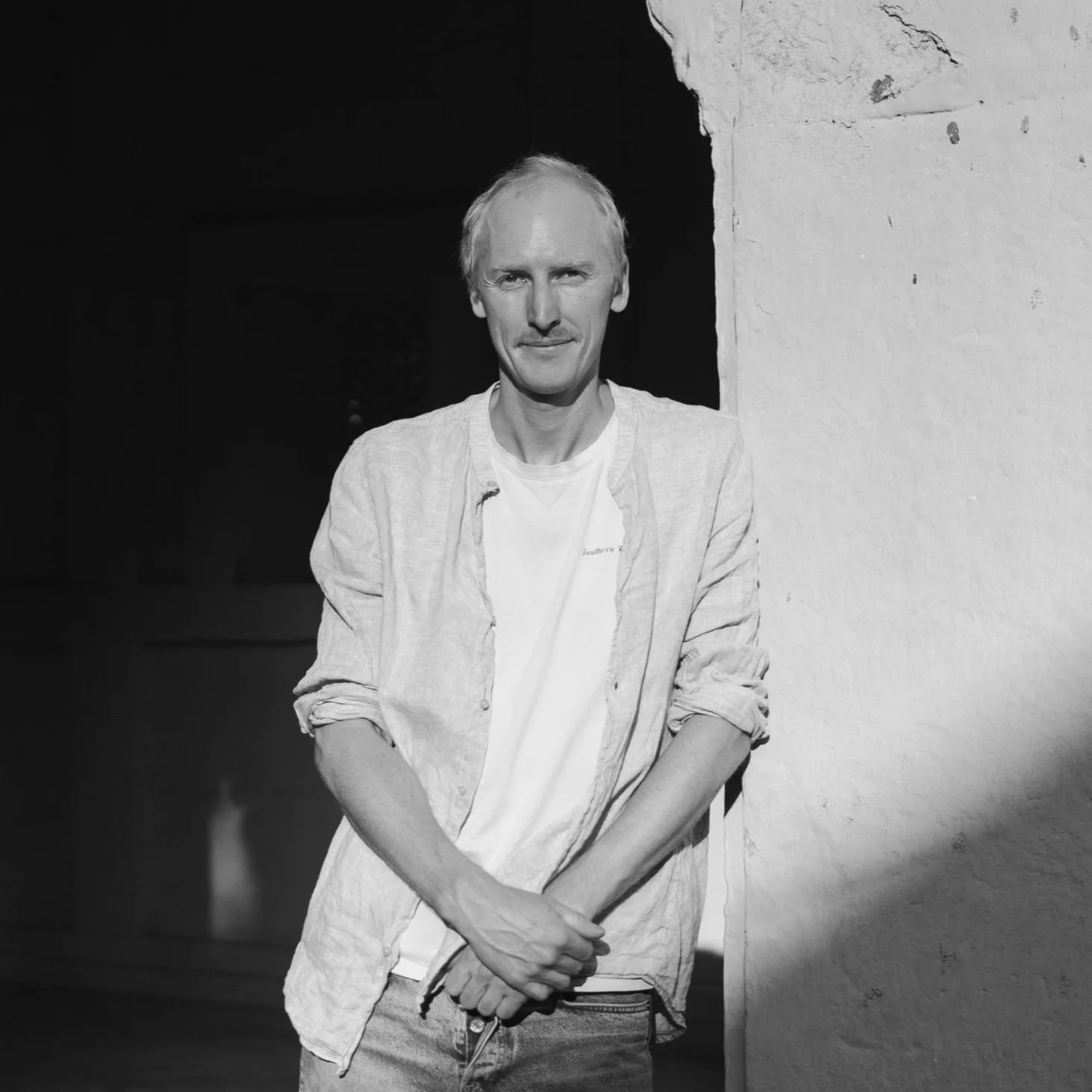
Gaspard Combes
Gaspard Combes (b. 1993, France/Switzerland) is an artist whose sculptural practice merges megalithic references with everyday contemporary objects. His hybrid forms, often infused with subtle humor, explore the tension between ancient symbols and modern artifacts, juxtaposing consumption and spirituality, urbanity and nature. Through these contrasts, Combes reflects on the speed of modern life and our diminishing capacity for critical reflection and shared imagination.
He has participated in international exhibitions and residencies including Villa Swagatam (India), Nouveau Grand Tour (Italy), Passages Insolites #10 (Canada), Côa: Corridor of Arts (Portugal), Megalithomania at Galerie Palais (Switzerland), and the UMOJA Residency (Tanzania), supported by the Goethe-Institut. His work continues to search for a balance between the archaic and the futuristic, grounding existential inquiries within everyday experience.
-

Jenjum Gadi
Jenjum Gadi’s (b. 1982, Tirbin, Arunachal Pradesh) artistic practice is deeply rooted in his connection to nature, and tradition. His love for Pichwais stems from his love for the art form and his admiration for Krishna, whom he associates with nature, love, and compassion-qualities that also define his work.
Beginning his journey in fashion, Jenjum skillfully wove traditional Northeastern textiles into contemporary designs before transitioning into fine art, where his meticulous hand-embroidered Pichwais became an extension of his reverence for craftsmanship. Now, through brass Repoussé and Chasing techniques, he transforms these narratives into sculptural forms, merging the fluidity of textile with the permanence of metal.
His latest works further deepen this dialogue, casting fruits from his childhood with delicate Pichwai depictions, blending personal memory with divine imagery. Whether in thread or metal, his art is an offering-an exploration of heritage, material, and the intimate ways in which spirituality and craft intertwine.
-
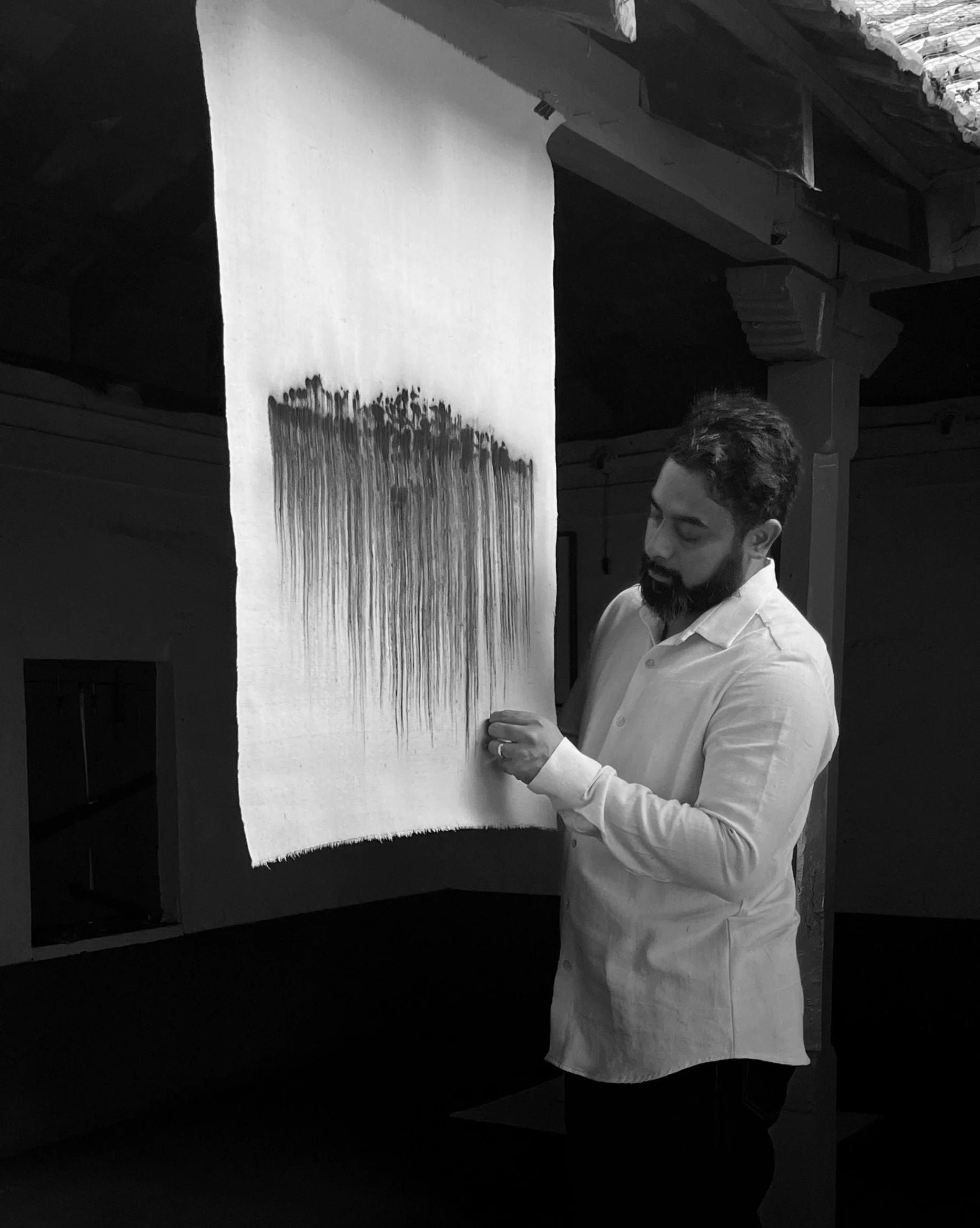
Kaimurai
Kaimurai (b. 1984, Bengaluru) is the artistic practice of Abishek Ganesh J, rooted in ritual, abstraction, and the metaphysical. Drawing on ancestral connections to indigo, his work channels memory, time, and devotion through meditative markings. Using natural indigo on textiles, paper, and canvas, he creates visual totems, circles, stains, and repetitions that reflect a spiritual inquiry shaped by personal experience and inner rhythm.
“Kaimurai,” meaning “method of hand” in Tamil, reflects his intuitive, process-led approach. Influenced by the mysticism of Carnatic music and the organic patterns of the natural world, his compositions hover between movement and stillness, becoming sites of reflection and surrender. Each work unfolds like a quiet invocation, where mark-making becomes a form of prayer and presence.
Kaimurai’s solo exhibitions include Drigganita at Bikaner House, New Delhi (2024), Divine Blue at Kaash Foundation, Bengaluru (2022), and Shadjam at Blueprint12, New Delhi (2021). He has participated in major institutional exhibitions such as Sutr Santati at the Melbourne Museum (2023) and the National Gallery of Modern Art, Mumbai. His work is also in the Kiran Nadar Museum of Art (KNMA) collection.
-

Laxmipriya Panigrahi
Laxmipriya Panigrahi (b. 1989, Baleshwar, India) is an artist known for her miniature-inspired surreal landscapes. She studied painting at Balasore Art and Crafts College (BVA, 2013) and Utkal University of Culture (MVA, 2015), Odisha. Her practice draws from traditional Orissan styles like miniature and pattachitra painting, working primarily with watercolour on paper. Her intricate, fantastical compositions radiate joy and vibrancy.
Panigrahi has received the National Award (2022), Silver Kalakand Grant (Prafulla Dahanukar Art Foundation, 2021), Odisha State Award (2019), Emerging Artist Award, and the 91st AIFACS Award (2018). Recent shows include Untethered Cartographies (Anant Art, 2025), Art Dubai (2024), Off Margins (Art and Charlie, 2024), and The Figure of Sound (Shridharani Gallery, 2023). She lives and works in New Delhi.
-
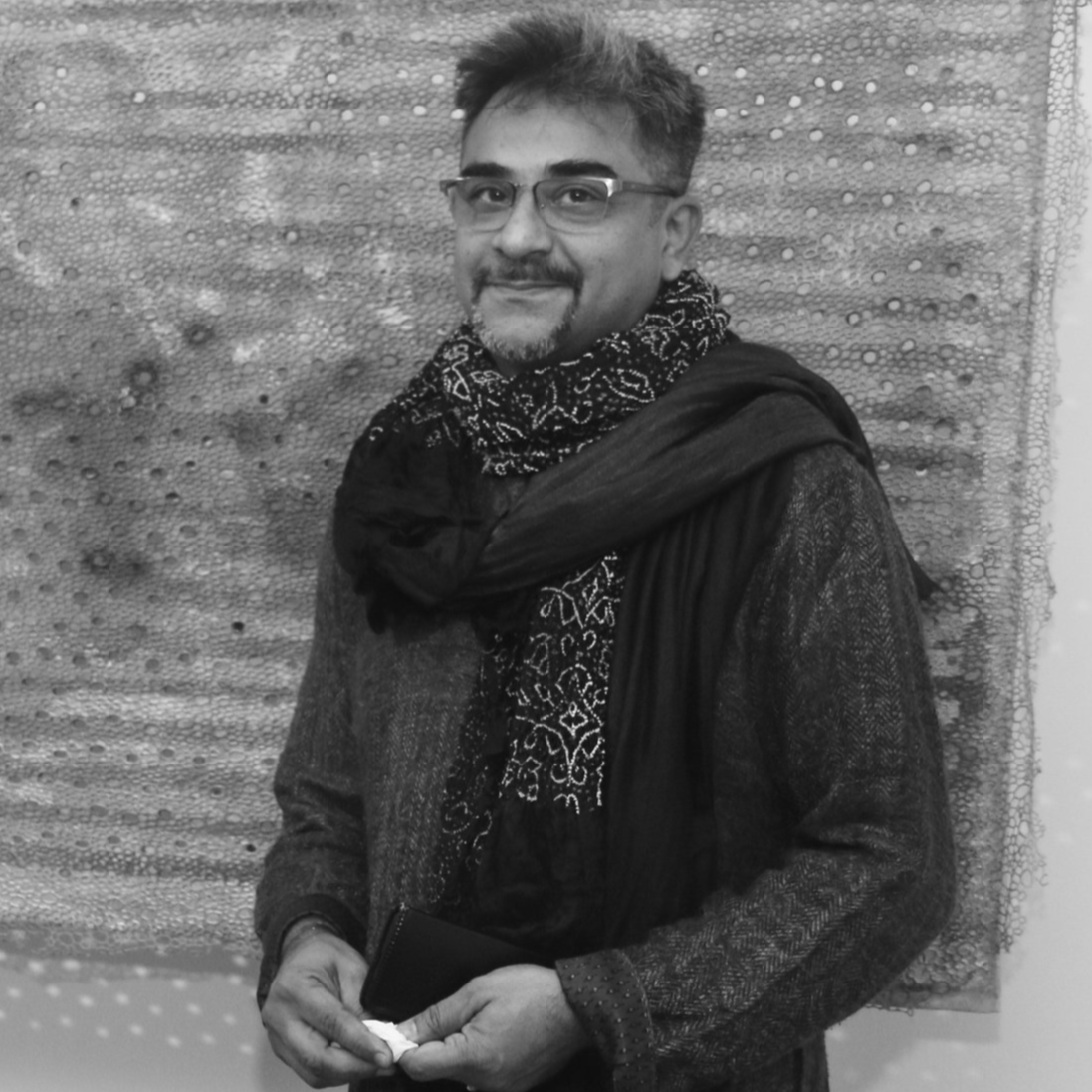
Puneet Kaushik
Puneet Kaushik (b. 1972, New Delhi) is a multidisciplinary artist whose textile and installation works blend traditional craft with contemporary expression. A graduate of Jamia Millia University and the University of California, Berkeley, he integrates techniques like Tibetan beadwork, Bidri inlay, and Patachitra into richly layered works. His major commissions include two large-scale installations for India’s new Parliament as part of the Central Vista Project, created with over 300 artisans.
With a career spanning over two and a half decades, Kaushik has curated for the Vice President’s residence, collaborated with the Aga Khan Foundation and the India Hub in Turin, and mentored craftspeople across India. He is a recipient of the Chivas Studio Artist of the Year Award and a Junior Research Fellowship from the Ministry of Culture. His work is held in major private collections, including the Kiran Nadar Museum of Art.
-

Raqs Media Collective
Raqs Media Collective was formed in 1992 in Delhi by Jeebesh Bagchi, Monica Narula, and Shuddhabrata Sengupta. Known for their interdisciplinary approach, they work across installation, video, photography, print, text, and performance, exploring the intersections of time, history, and urban experience. Their practice is deeply rooted in critical inquiry, often engaging with archives, philosophical concepts, and socio-political contexts to create poetic and thought-provoking works.
Over three decades, Raqs has exhibited globally at major museums, biennales, and public spaces, gaining recognition as leading voices in contemporary art. They co-founded Sarai, a research and media initiative, and often curate and write alongside their artistic practice. Their work challenges viewers to question power, knowledge, and narrative in a rapidly changing world.
-
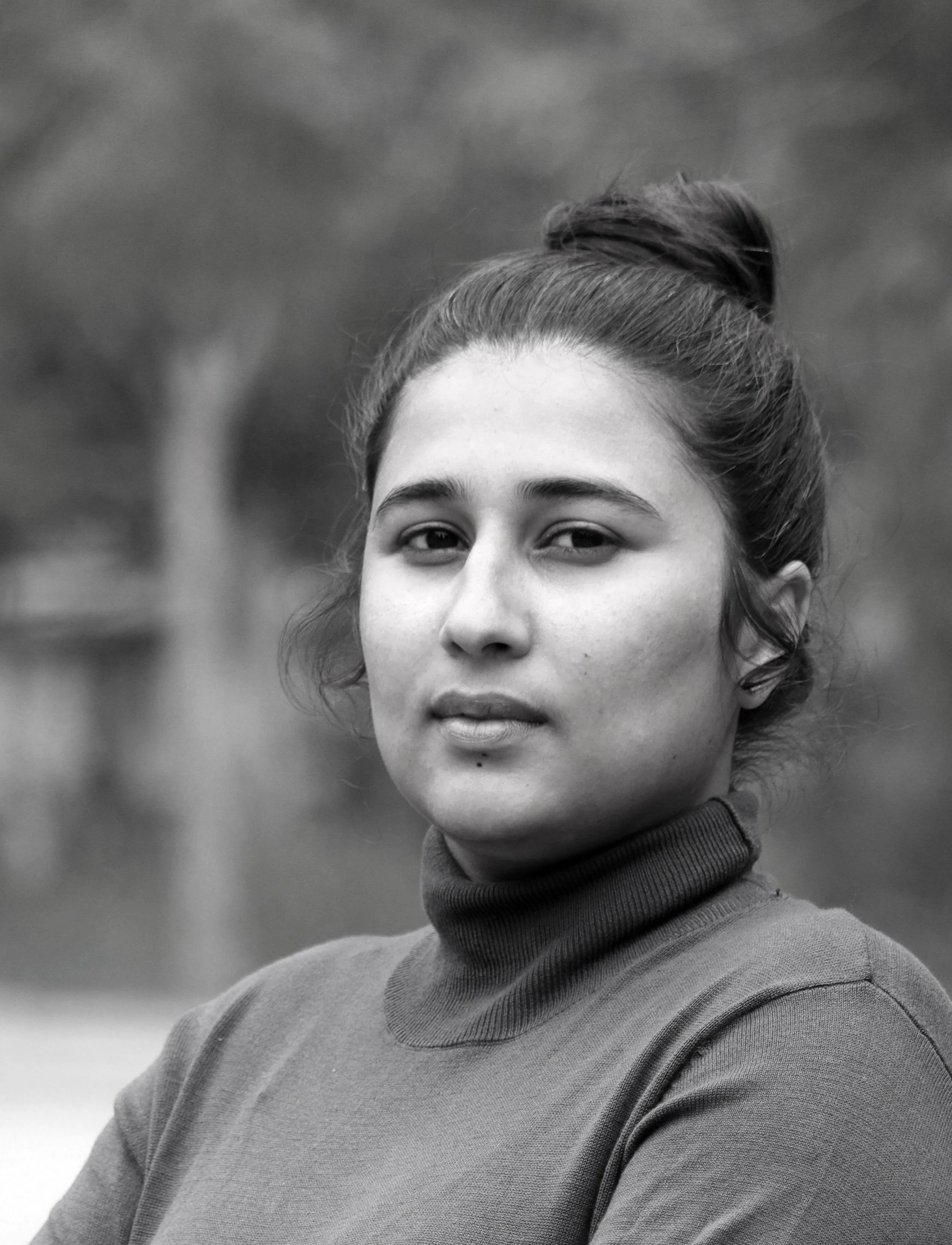
Richa Arya
Richa Arya (b. 1997, Samalkha, Haryana) is a multidisciplinary artist whose work explores the intersecting themes of gender, migration, and labor. Drawing from her own life, oral histories, and archival research, Arya examines the realities of women working in urban textile factories, narratives of empowerment, exploitation, and shifting identities. Through weaving, stitching, and fabric manipulation, she transforms industrial processes into intimate visual languages rooted in care, resilience, and critique.
Arya holds an MFA in Sculpture from the College of Art, Delhi, and a BFA from Kurukshetra University. She is the recipient of the FICA Emerging Artist Award (2024) and has participated in residencies and art festivals in South Asia such as KHOJ Peers (2022) and Serendipity Arts (2023) respectively. Her recent exhibitions include Unseen Shadows at Exhibit 320, New Delhi (2024), where her work continues to foreground the lived experiences of working-class women within India’s contemporary art discourse.
-

Saruha Kilaru
Saruha Kilaru (b. 1998, Faridabad, Delhi NCR) is a multidisciplinary artist working with printmaking, colour theory, and material processes. A graduate of the MA Print program at the Royal College of Art, her work explores repetition, pressure, and perception as poetic and psychological tools. Her sensitivity to colour is central to her meditative practice, which spans textiles, monoprints, and installations.
Kilaru has exhibited at Woolwich Contemporary Print Fair, Southwark Park Galleries, and the MP Birla Millennium Gallery in London, as well as Artbuzz and Bikaner House in Delhi. She has received awards including the High Prize for Artistic Excellence (2022) and the Travers Smith Art Award. In 2024, she co-founded Calhi Studios in Delhi, a collaborative, multidisciplinary space rooted in experimentation and materiality, continuing to grow as a hub for community-led creative practices.
-
Shailesh BR
Shailesh BR (b. 1986, Karnataka) is a visual artist based in Delhi NCR whose practice bridges ancient knowledge systems and contemporary scientific inquiry. Trained in Sanskrit and once a professional priest, Shailesh brings metaphysical and philosophical perspectives into kinetic sculptures, installations, and schematic drawings. His work explores the convergence of ritual, myth, and abstract logic, offering a deeply personal and speculative engagement with knowledge-making across time.
He holds a BVA from CAVA, Mysore, and a Diploma in Fine Arts from MS University, Baroda. His recent participation includes the Connect India Residency at CERN and ICTS (2024), where he researched energy through both scientific and philosophical lenses. His work has been shown at Vadehra Art Gallery, Villa Arson (Nice), Sea Art Festival (Busan), and through residencies at IST (Vienna) and ACC (Gwangju). He is a recipient of the FICA Emerging Artist Award (2015) and the Nasreen Mohamedi Award.
-
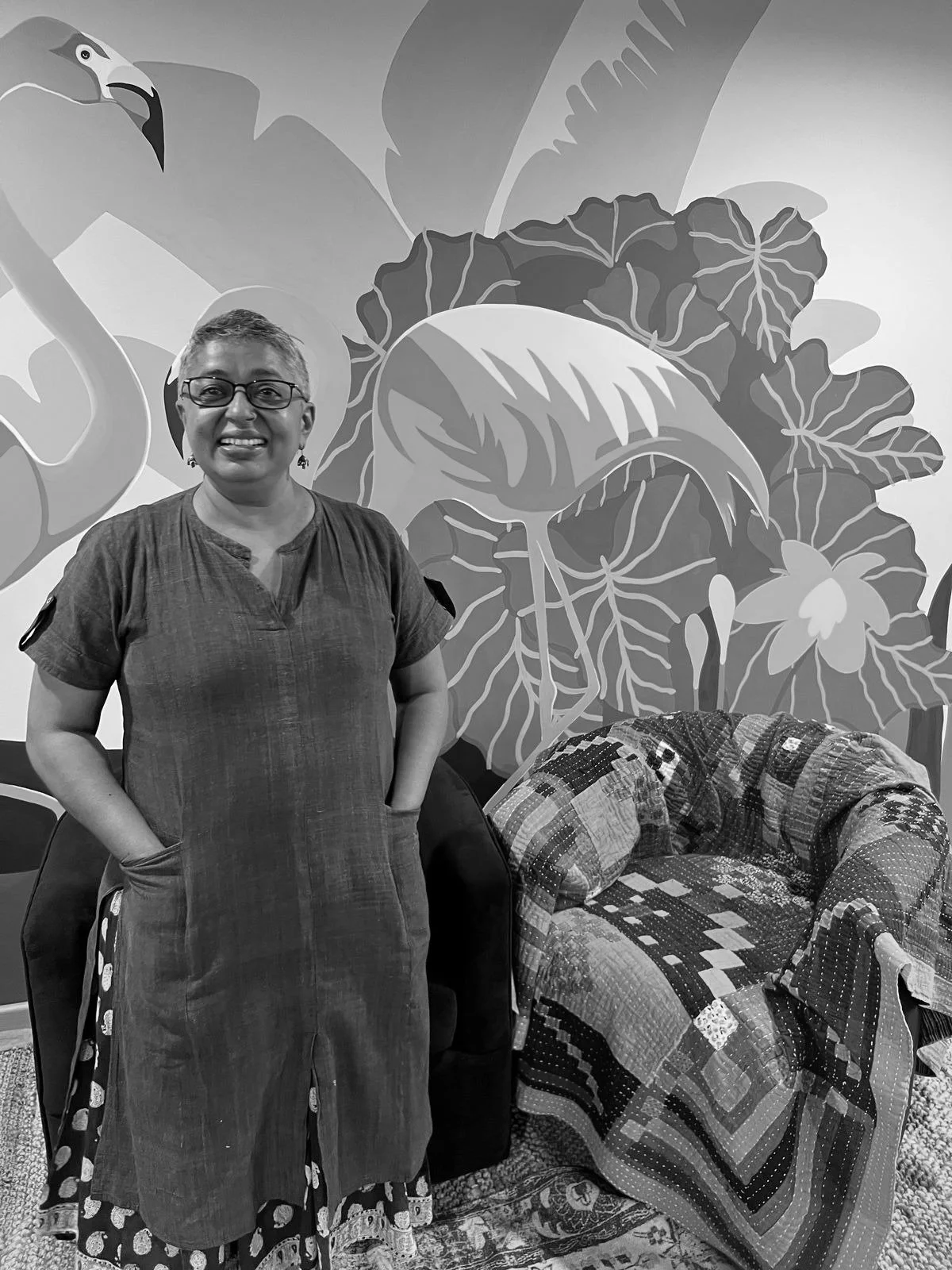
The Siddi Women Quilters x Anitha N Reddy
The Siddi Women Quilters, represented by Ladamabi Mandvekar, Husenbi Jamadar, and Hattarabi Gunjavati, are a collective of textile practitioners from rural Uttara Kannada and Dharwad, Karnataka. In collaboration with Anitha N Reddy (b. 1973, Bangalore)—a community-based artist, researcher, and textile historian—they have been creating kavands (quilts) from upcycled fabric scraps for over a decade. Their work preserves ancestral memory, fosters creative agency, and challenges craft hierarchies through socially engaged practice.
In 2023, Reddy received a year-long research and engagement grant from the Victoria and Albert Museum, London. Their quilts were exhibited in O Quilombismo at Haus der Kulturen der Welt (HKW), Berlin, and showcased in a workshop and sale at the International Folk Art Market (IFAM), Santa Fe.
Reddy is currently co-developing a community lab with a New Jersey museum, and her project Hinged by Fabric was recently presented at the Atlassian Foundation, Bangalore.
-
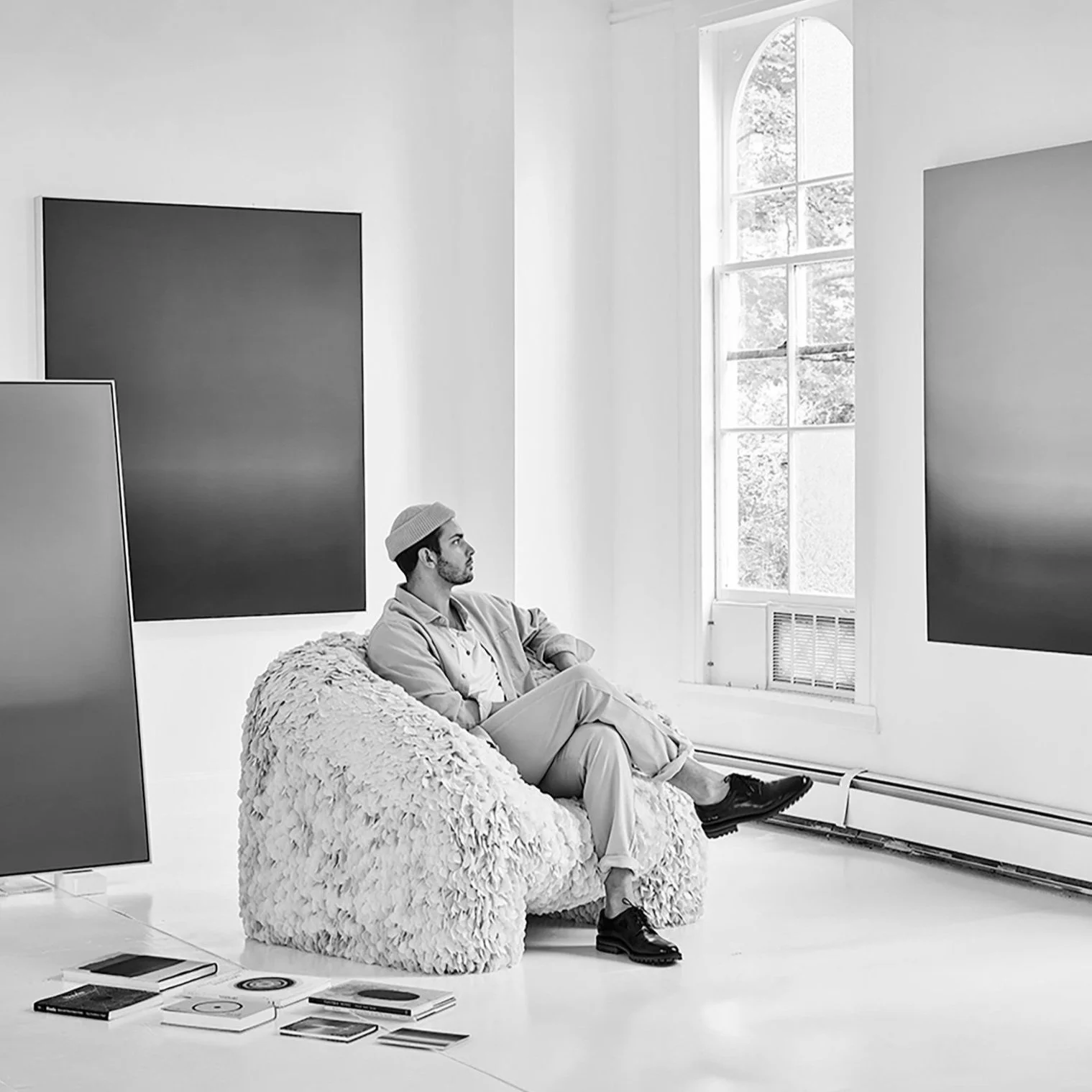
Theo Pinto
Theo Pinto (b. 1990, Brazil) is a visual artist and art director whose practice spans painting, architecture, and immersive spatial design. Formally trained at the Maryland Institute College of Art (MICA) and DIS Copenhagen in architecture, Theo’s paintings combine bold abstraction with intuitive composition, drawing from both built environments and personal memory. He has exhibited internationally at galleries including Nature Morte (Mumbai), ACA Gallery (New York), Cadogan (London/Milan), The Pill (Istanbul), and 1x1 Gallery (Dubai).
Alongside his studio practice, Pinto has worked as an art director creating large-scale spatial experiences for institutions and brands such as the Obama Presidential Center, Fashion for Good Institute, Uber, Samsung, Revlon, and Under Armour. Bridging fine art and design, his work invites reflection on movement, perception, and the politics of space.
-
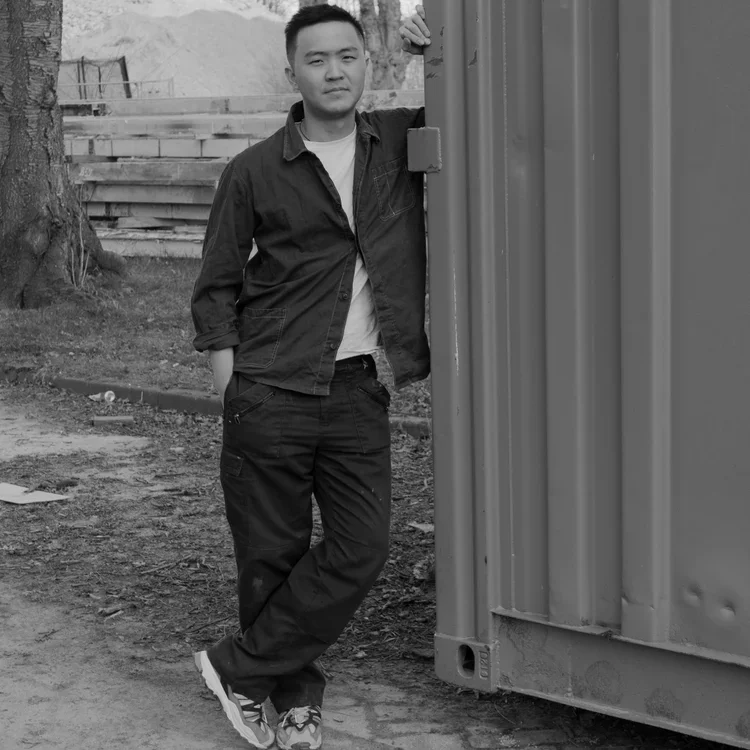
Zavier Wong Zhen Rui
Zavier Wong Zhen Rui (b. 1993, Singapore) is a designer and artist based in the Netherlands whose material-led practice bridges craft, sculpture, and object design. A graduate of the Design Academy Eindhoven under Nacho Carbonell, Wong describes himself as “gardening in an industrial wilderness,” reclaiming discarded or imperfect materials to reveal their hidden potential. His work centers on transformation, of materials, perceptions, and meaning, creating poetic objects that challenge conventional notions of value and function.
Since founding his studio in 2021, Wong has worked as a skilled metalworker at Studio Job while developing an independent practice marked by experimentation and sensorial engagement. Through an intuitive process of negotiation with materials, he reanimates the overlooked and unwanted, offering viewers new ways of experiencing matter and beauty. His evolving body of work invites wonder, empathy, and reflection in a world shaped by waste and utility.

